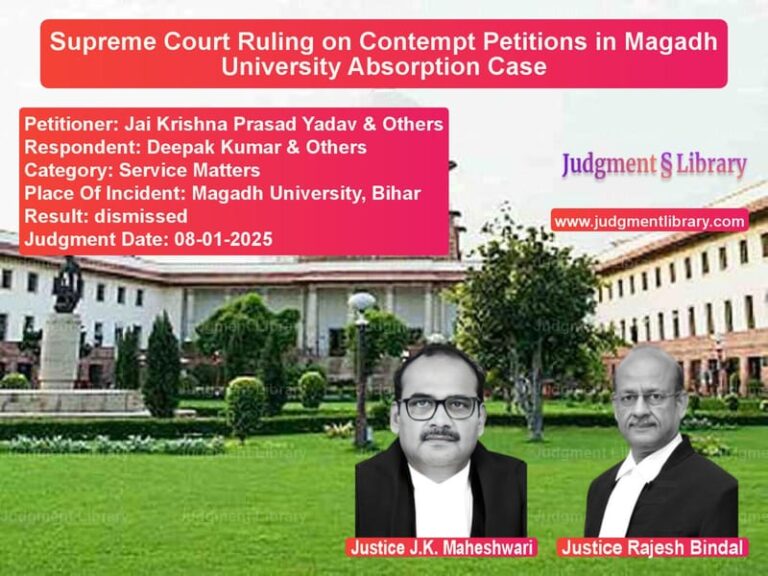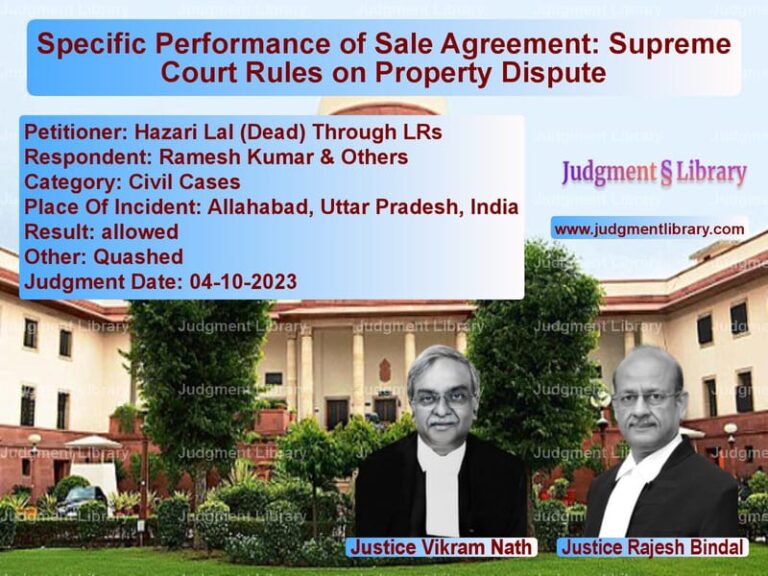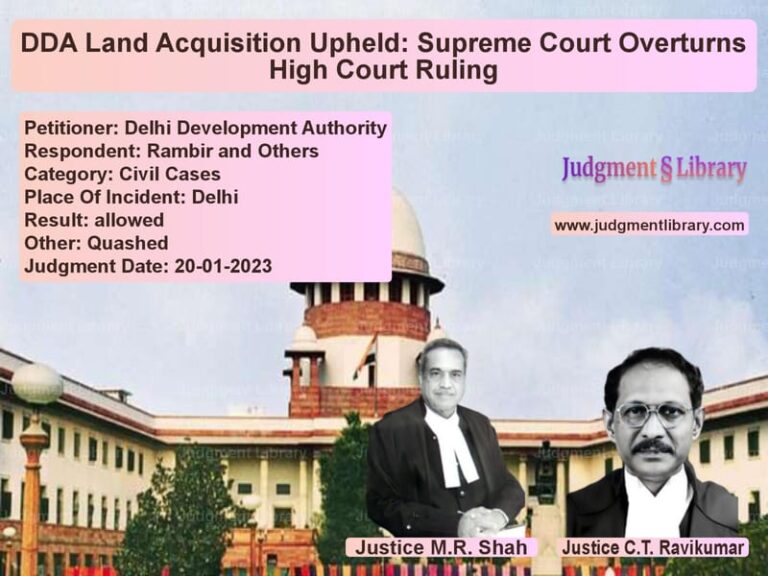Forgery Allegations in Civil Litigation: Supreme Court Clarifies Section 195 CrPC
The case of Vishnu Chandru Gaonkar v. N.M. Dessai revolves around allegations of forgery in a civil appeal withdrawal application. The dispute centers on whether an advocate fraudulently used a deceased litigant’s thumb impression to file a withdrawal application and whether such an allegation requires a complaint under Section 195(1)(b)(ii) of the Criminal Procedure Code (CrPC). The Supreme Court ultimately ruled that the complaint was not maintainable, clarifying the legal position regarding forgery allegations related to court documents.
Background of the Case
The case originates from a civil dispute over property, where:
- A civil suit (No. 4 of 1993) was filed by two plaintiffs, including the appellant, against two defendants.
- The suit was decreed in favor of the plaintiffs on December 7, 2001.
- The defendants filed Civil Appeal No. 91 of 2004 challenging the decree.
- One of the appellants in the appeal, Shaba Manju Velip, died on March 2, 2005, but no substitution application was filed to replace him with his legal heirs.
- Subsequently, the appellants in the civil appeal decided to withdraw it and filed an application to that effect on July 18, 2006.
- The execution case for enforcing the decree was also withdrawn on July 21, 2006.
Later, the appellant, Vishnu Chandru Gaonkar, filed a complaint alleging that the advocate for the appellants in the civil appeal, N.M. Dessai, forged the thumb impression of the deceased Shaba Manju Velip on the withdrawal application.
Arguments by the Petitioner
The petitioner, Vishnu Chandru Gaonkar, argued that:
- The withdrawal application contained a forged thumb impression of the deceased appellant, making it a case of forgery.
- The act of filing a forged document in court required an inquiry and prosecution under Section 195(1)(b)(ii) of the CrPC.
- The District & Sessions Judge correctly ordered an inquiry and the filing of a complaint against the respondent under the relevant provisions.
Arguments by the Respondent
The respondent, N.M. Dessai, countered that:
- He was not aware of the death of Shaba Manju Velip at the time of filing the withdrawal application.
- Another individual, Vimal Shaba Velip, stated that she mistakenly placed her thumb impression on behalf of her deceased husband, believing it was permissible.
- Since the alleged forgery occurred outside the court proceedings, the complaint under Section 195(1)(b)(ii) of the CrPC was not maintainable.
- The withdrawal of the civil appeal did not impact the appellant’s rights, as the decree-holder’s legal heirs had also withdrawn the execution application.
Decision of the District & Sessions Judge
The District & Sessions Judge, on July 31, 2008, ruled in favor of the appellant and ordered an inquiry under Section 195(1)(b)(ii) of the CrPC, stating:
“The material on record indicates that an offense of forgery under Section 463 IPC has allegedly been committed to withdraw the appeal by misrepresenting the deceased as living.”
High Court’s Decision
The High Court of Bombay at Goa overturned the Sessions Judge’s ruling and quashed the complaint, holding that:
- The alleged forgery took place before the document was submitted in court.
- As per the Supreme Court’s ruling in Sachida Nand Singh v. State of Bihar, Section 195(1)(b)(ii) of the CrPC applies only when forgery occurs after a document is produced in court.
- Since the alleged act of forgery took place outside court proceedings, a complaint under Section 195(1)(b)(ii) was not maintainable.
Supreme Court’s Analysis and Ruling
The Supreme Court upheld the High Court’s decision, clarifying the applicability of Section 195 CrPC. It relied on its Constitution Bench ruling in Iqbal Singh Marwah v. Meenakshi Marwah, which held:
“Section 195(1)(b)(ii) applies only to offenses committed after a document is produced or given in evidence in a proceeding. If the document was forged before being produced, the complaint is not covered under this provision.”
The Court observed that:
- The withdrawal application had been signed and thumb impressions obtained before being submitted in court.
- The alleged forgery was committed before the document was filed in judicial proceedings.
- Any prosecution for forgery must be initiated under general penal provisions (such as Sections 463 and 471 of the IPC) rather than through a complaint under Section 195(1)(b)(ii).
Accordingly, the Court dismissed the appeal, stating:
“The High Court rightly concluded that no complaint could be proceeded with under Section 195(1)(b)(ii). We find no merit in this appeal.”
Key Takeaways
- Forgery committed before a document is produced in court does not fall under Section 195(1)(b)(ii) of the CrPC.
- A complaint under Section 195 CrPC can only be filed for offenses committed after a document is introduced in judicial proceedings.
- General forgery allegations must be prosecuted under the Indian Penal Code (IPC) rather than through court-initiated complaints.
- The ruling clarifies the distinction between forgery committed inside and outside judicial proceedings.
- The judgment prevents the misuse of Section 195 CrPC for allegations of forgery unrelated to judicial proceedings.
Conclusion
The Supreme Court’s ruling in this case reinforces a crucial legal principle: Section 195 CrPC applies only when an offense related to a document occurs during judicial proceedings, not before. By dismissing the appeal, the Court ensured that forgery cases occurring outside the judicial process must be prosecuted under the Indian Penal Code rather than through court-initiated complaints.
This judgment serves as an important precedent for future cases involving allegations of forgery in civil litigation, ensuring clarity in the application of criminal law in judicial proceedings.
Petitioner Name: Vishnu Chandru GaonkarRespondent Name: N.M. DessaiJudgment By: Justice A.K. Sikri, Justice Ashok BhushanPlace Of Incident: GoaJudgment Date: 06-03-2018
Don’t miss out on the full details! Download the complete judgment in PDF format below and gain valuable insights instantly!
Download Judgment: Vishnu Chandru Gaonk vs N.M. Dessai Supreme Court of India Judgment Dated 06-03-2018.pdf
Direct Downlaod Judgment: Direct downlaod this Judgment
See all petitions in Fraud and Forgery
See all petitions in Bail and Anticipatory Bail
See all petitions in Legal Malpractice
See all petitions in Judgment by A.K. Sikri
See all petitions in Judgment by Ashok Bhushan
See all petitions in dismissed
See all petitions in Quashed
See all petitions in supreme court of India judgments March 2018
See all petitions in 2018 judgments
See all posts in Criminal Cases Category
See all allowed petitions in Criminal Cases Category
See all Dismissed petitions in Criminal Cases Category
See all partially allowed petitions in Criminal Cases Category







